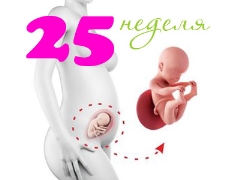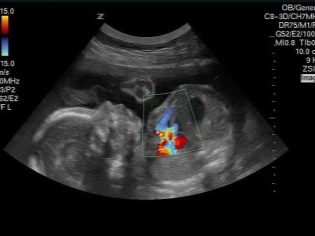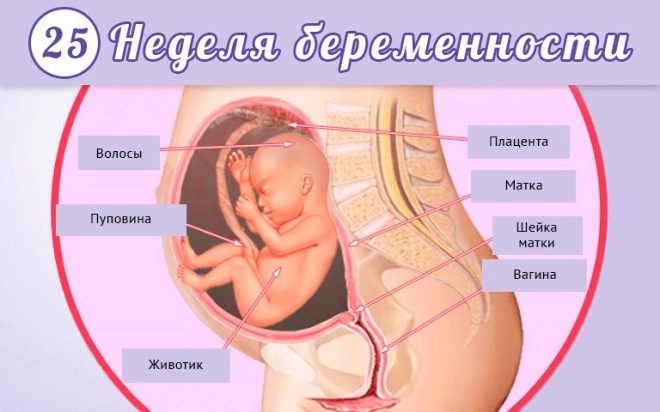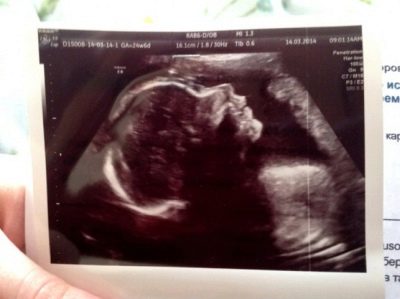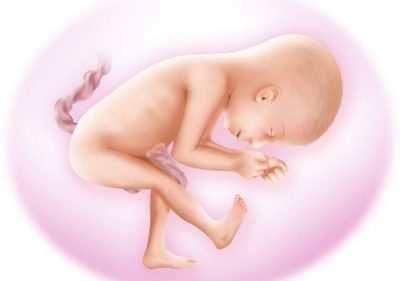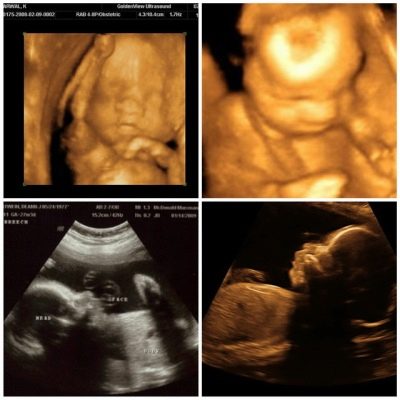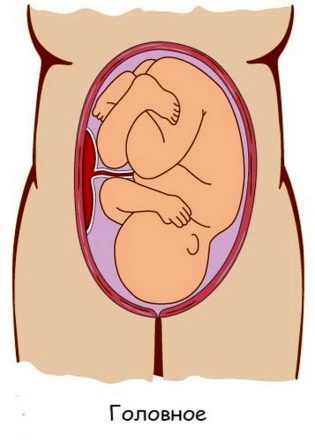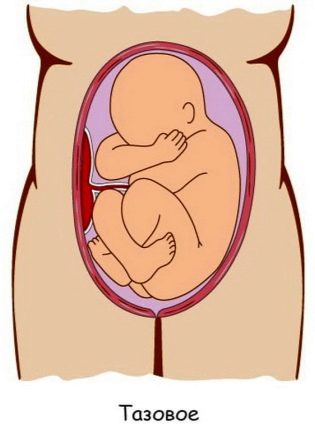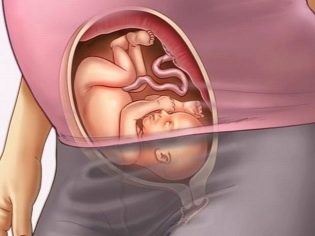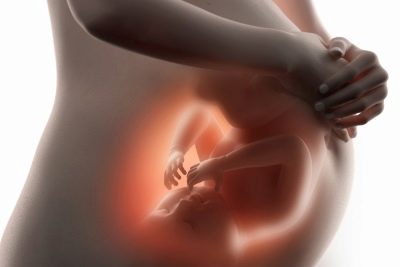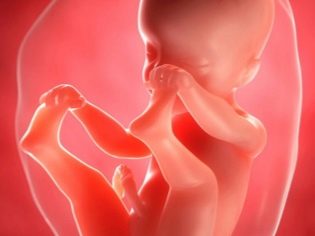Fetal development in the 25th week of pregnancy
25 week of pregnancy is characterized by a number of specific changes in the body of the fetus.
Body parameters
The main body sizes of the fetus are very important - they give doctors information about how well the fetal development of the baby proceeds.
To determine the basic parameters of the body of the fetus, experts use an ultrasound diagnostic method called fetometry. During this study, the specialist determines the basic dimensions of the body of the fetus, making special measurements. After that, he brings them into his medical report, which is subsequently issued to a pregnant woman.
The most important criteria for determining the parameters of the body of the fetus are its height and weight. With each subsequent day of pregnancy, the baby weighs more and more, but the growth increases less intensively. The normal values of the studied parameters of the body of the fetus are presented in the table below.
Determined clinical sign | Norm at 25 weeks gestation |
Growth | 33.5-34.5 cm |
Weight | 600-700 grams |
Head diameter | 62.3 mm |
Belly diameter | 64.2 mm |
The diameter of the chest | 63.1 mm |
Heartbeat
Evaluation of the cardiovascular system in the fetus is very important. It shows how well the heart pumps blood through the blood vessels. For intensive intrauterine development, it is necessary that the work of the cardiovascular system is not disturbed.
Doctors use a special clinical criterion called heart rate (HR) to assess the performance of the heart. Even the future father can count it. To do this, he should put his head to the belly of his spouse, where the baby “lives” and listen. The number of beats per minute is called heart rate.
More precisely, the heart rate of the fetus is determined by conducting an ultrasound examination and listening to the heart rate with an obstetric stethoscope. Normal values of heart rate in a baby during this period of his prenatal life are 140-150 beats per minute.
If the fetal heart rate is within the normal range, then doctors call this condition normocardia. In this case, worry about the condition of the baby is not worth it. A significant decrease in the heart rate below normal indicates that the fetus has developed bradycardia, and the heart palpitations are called tachycardia.
It is important to remember that the periodic increase or slowing of the heartbeat of the fetus may be. However, if this condition persists for a fairly long period of time, then in such a situation, a pregnant woman should always consult with her doctor.
Appearance
The fruit looks very funny - it already clearly resembles a person, but only in miniature. Every day the configuration of the baby’s body gradually changes. The head no longer seems so huge in relation to the body.
The fetus has already formed feet. On each foot there are small fingers, their terminal phalanges cover the nails. The joints on the arms and legs are quite mobile. The baby is already quite good at bending and unbending the arms, moving the legs.
On the body of the child there are small gun hairs. Experts call this fetal hairline lanugo. In the future, this hair will disappear, and the baby’s skin will become smooth and even.
The color of the skin of the fetus - pink with a slight grayish tint, which gives a special original lubricant. It is formed due to the functioning of the sweat and sebaceous glands - their secret is mixed with exfoliated epithelium, which forms a lubricant. Such a "coating" is necessary for the baby in this period of its intrauterine development. It helps to protect the very delicate and vulnerable skin of the child from various mechanical influences and improves its mobility in the aquatic environment.
On the face of the baby's eyes are clearly visible. The kid can already open them. Eyes outside are covered for centuries. The skin of the eyelids is still thin and even transparent, a thin thread of blood vessels appears through it. In a few weeks, the baby’s eyelid skin will be more dense.
Above the eye crevices grow short hairs that form the eyebrows. As a rule, they have a light color, but later it will change. The hereditary factor affects the color of eyebrows and eyelashes.
Every day, changing the contours of the nose and chin. So, they become more clearly defined. The forehead no longer seems so flat. The fetus already has cheeks, only they are not yet plump - this is due to the fact that the baby does not have enough fatty tissue.
Insufficient fat under the skin contributes to the fact that the baby looks pretty thin. The formation and accumulation of drilling fat in the fetus occurs gradually. With each subsequent week of pregnancy, its amount will increase, and by birth it will already be enough for the independent life of the child.
By the 25th week of gestation, babies already have basic sexual characteristics. An ultrasound specialist can quite easily determine the sex of a baby. Eggs are already formed in girls, and the prostate gland is formed in boys.
Location in the womb
The baby may be located in the womb in different ways. Its most favorable location is when the baby’s head is pointing down towards the birth canal. This presentation is called the head. When the head previa during childbirth first born baby's head, and then other parts of his body. In this case, the probability of development of birth injuries and various injuries to the mother and fetus is quite low.
A less favorable option in the uterus is pelvic presentation. In this case, not the head of the baby, but its pelvic end is closer to the pelvic bottom of the mother. In this case, the birth of the head first is impossible, but independent natural childbirth with pelvic presentation of the fetus is quite dangerous. Doctors note that perinatal mortality during childbirth with this position of the fetus in the uterus is still high.
In order to prevent the development of dangerous birth injuries, obstetrician-gynecologists choose a surgical method of obstetrics. To do this, with a pelvic presentation of the fetus, a caesarean section is performed.
Also, the expectant mother, whose baby is in pelvic presentation, should rather carefully monitor their state of health. The appearance of warning signs should be an urgent reason for the woman to consult a doctor. So, leakage of amniotic fluid or abundant blood discharge from the genital tract are adverse symptoms that require urgent medical consultation.
It is important to remember that in the 24-25 week of pregnancy, the presentation of the fetus is not yet final. The mobile and active child, making numerous movements, can completely change its position in the uterus before its birth.
Doctors evaluate how the baby “lies” in the womb, several times during the entire pregnancy. They also necessarily evaluate the position of the fetus in the uterus before the upcoming birth.
Physical activity
At the 25th week of pregnancy, the volume of active movements in the fetus increases significantly. This feature is largely due to the fact that the baby has a well-developed nervous system and musculoskeletal system. Thus, the mass of the brain in the fetus at 24-25 weeks of pregnancy is about 100-110 grams. The elasticity and contractility of the muscles is also quite high.
Such features of prenatal development of the baby contribute to the fact that he begins to quite actively explore the water world in which he lives. So, the child begins to push off the legs of the uterus. Such movements contribute to the fact that a pregnant woman feels like her baby is kicking.
The first stirring of the child causes his future mother, as a rule, a lot of different emotions. Many women note that at that moment they felt imminent motherhood. The future mom can feel the baby's movements in different ways. Pushes in her stomach appear, as a rule, below or in the lateral parts of the abdomen. It depends on the location of the baby in the uterus.
It is important to note that the baby already has the ability to circadian rhythm. This means that the child is awake during the day and sleeps at night. Scientists have found that during this period of pregnancy the fetus is able to sleep for about 16-19 hours. At other times, the baby can be quite active and mobile.
Motor activity of the fetus is an important clinical criterion for its intrauterine development. So, if the baby is experiencing some discomfort, he begins to kick more often and more intensively. Such a “feedback” with the mother is conceived by nature so that a pregnant woman can independently determine the condition of her child.
Too vigorous activity of the baby should be a mandatory occasion for consultation with a doctor who observes the course of pregnancy. In some cases, hypoxia - oxygen deprivation of tissues and internal organs - contributes to an increase in the motor activity of the fetus. Hypoxia occurs, as a rule, with insufficient oxygen supply.
It should be noted that the motor activity has also individual features. So, if the baby is pretty calm, then he will move and kick in his mom's belly much less than a restless person.
Feelings of the fetus
In the 25th week of pregnancy, the children's body is already quite well developed. His senses are already functioning, through which the child can experience the outside world. Of course, truly nerve analyzers will function only after the birth of a baby.
The fetus at 25 weeks gestation is able to hear various sounds. For example, too loud sounds can cause discomfort to the child. He will “inform” his mom about this by starting to kick strongly in her stomach.
The fruit can also distinguish voices. So, he particularly well distinguishes the maternal voice. Scientists have proven that the voice of the mother has a calming effect on the child. That is why doctors recommend future mothers to talk with their babies already during pregnancy - this will form a positive psycho-emotional connection.
The baby is also able to respond to light. It is proved that bright light stimuli lead to increased fetal motor activity. So, the kid tries to turn away from the too bright light that falls on his face.
In addition to the visual and auditory analyzer, the taste analyzer gradually begins to function in the child. Baby, swallowing amniotic fluid, is able to distinguish its taste. So, the amniotic fluid can be sweet, brackish or even bitter. Perhaps the definition of taste due to the special microscopic processes - the papillae, which are located on the tongue.
Intensive intrauterine development is also accompanied by a rapid growth of internal organs. So, the child’s intestines are already starting to work. The liver of the baby forms bile, which is involved in the formation of meconium. The fetus also has kidneys and can urinate.
About what happens in the 25th week of pregnancy, see the next video.
